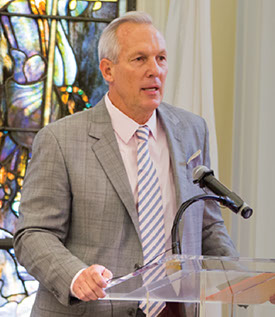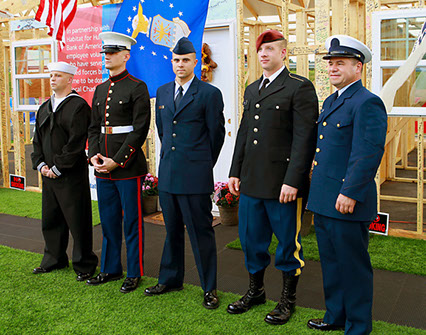
Investing in Veterans
Supporting veterans can take many forms, but employment opportunities can be crucial for re-entering civilian life. Some companies go further than just recruitment, recognizing that full-bodied veterans programs can benefit the entire company as well as the communities that surround them.
For nearly a century, Bank of America has seen the value of investing in veterans, not just by hiring them, but also by mentoring them, partnering with organizations that serve them, and providing tools and programs to ensure they succeed and thrive. These efforts are coordinated across the company - Human Resources works in tandem with individual business lines to develop leadership programs targeted specifically at veterans. The company also has a dedicated Military Affairs team – a group of leaders focused on service members and their families – who play a key role in veterans’ successful reintegration into civilian life.
Spearheading the Military Affairs team is Jeffrey Cathey, the Military Banking Overseas Division Executive and  Senior Military Affairs Executive based in Tampa. Cathey truly understands the concerns of veterans, having served with distinction in the Navy for 29 years, where he led commands worldwide and successfully flew 100 combat missions. The Military Affairs team utilizes Bank of America’s diverse resources to provide support and opportunities to veterans in areas such as financial services and hiring, and has programs, resources and networks to help them succeed in their careers at the company.
Senior Military Affairs Executive based in Tampa. Cathey truly understands the concerns of veterans, having served with distinction in the Navy for 29 years, where he led commands worldwide and successfully flew 100 combat missions. The Military Affairs team utilizes Bank of America’s diverse resources to provide support and opportunities to veterans in areas such as financial services and hiring, and has programs, resources and networks to help them succeed in their careers at the company.
“We’re focused on transitioning service members and their families into positions at Bank of America, and telling them, ‘You landed in a good place.’ We decided that was where we could make a difference, and it’s also a way we can thank them for their service,” says Cathey.
In 2014, Bank of America committed to hiring 10,000 veterans, guard and reservists. According to Cathey, that commitment is anticipated to be met by the end of the year.
Bank of America has also provided more than $21 million in financial support to military nonprofits such as Student Veterans of America, USO, America’s Warrior Partnership, Institute for Veterans and Military Families, Team Rubicon, and Team Red, White & Blue. In 2018, it announced a $20 million Veteran Entrepreneur Lending Program to connect veterans with affordable capital to help kick-start and grow their businesses.
One Latina veteran employed with Bank of America is Tanya M.V. Edwards, a Senior Vice President/Senior Group Operations Manager with Bank of America’s Military Banking Overseas Division, who plays a critical role in contract administration between the bank’s overseas financial operations at 62 financial centers in 10 countries and the Department of Defense.
Edwards enlisted in the Navy at seventeen. “I wanted to prove that I could be successful on my own,” she says. “The Navy gives you an opportunity to learn things, it gives you tremendous appreciation of how blessed we are as a country, and how alike we are as Americans. It helps you appreciate what we have as opportunities. If you work hard and treat people with respect, you can go very far with your career.”
And that’s what she did, serving her country for 21 years, and retiring as a naval intelligence officer. She joined Bank of America in 2008 after relocating with her husband to Texas after responding to an ad for a position that matched her skill sets from the Navy.
According to Edwards, the transition into civilian life can be tricky. Military training can instill important skills like leadership, discipline, and determination but in a corporate setting, communication and instinct can also come in handy. She advises veterans, “Leave the past behind. Your military career was one chapter in your life, Bank of America is a new chapter, take the military experience you learned to help you succeed but also take advantage of programs the bank offers.”
These programs include financial services. Bank of America operates military banking facilities overseas in 10 countries, including 62 financial centers and 275 ATMs, managed through a contract with the Department of Defense. Since 2012, it’s donated more than 2,300 residential properties to military and veteran support organizations.
Sergeant and Marine Scout/Sniper James D. Galindo wasn’t sure how his skills would translate outside the Marines, but he decided to pursue sales and in 2011, became a contractor for Bank of America. Today, he’s a permanent employee and a Senior Relationship Manager in Global Commercial Banking.
“The bank has been very welcoming,” he says. “My roles here have enabled me to use the leadership skills I learned in the Marines. I have had seven promotions in eight years, managed three teams for the bank, and last year I was promoted to senior relationship management, to develop Ventura County. This is a result of the bank believing in me and enabling me to grow.”
Bank of America offers outlets for all its employees to support veterans through affinity groups like the Military Support and Assistance Group (MSAG) which has 39 chapters and more than 10,000 members, with networking, mentoring, volunteer events and information forums.
Rafael Ramirez, Vice President, Life and Specialty Services joined MSAG seven years ago after attending an event sponsored by Bank of America. Though not a veteran, he was welcomed by the veterans and their families, and enjoyed the group’s inclusive and giving culture. Today he chairs MSAG for the Greater Washington DC area. He coordinates volunteers at the company for military-oriented nonprofit organizations.
“We pulled together a toolkit for other employers to follow our example,” he says. “It’s an awesome way for Bank of America, who may have resources that others don’t, to support smaller organizations. As a result of our volunteers, we’re able to take what we know and have and share that with others. It’s been so rewarding seeing small organizations benefit, seeing our communities represented and supporting others in ways beyond financial aspects. It also builds camaraderie for our workforce.”
By Valerie Menard
